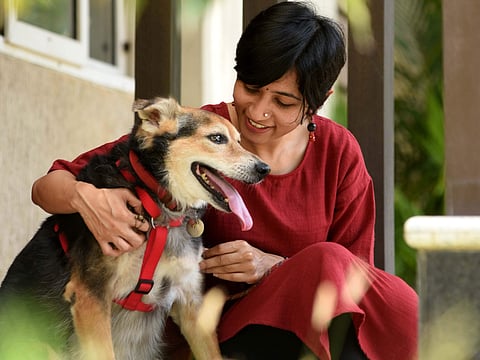

Aanya* was a girl who couldn’t get over her past. The trauma that stems from sexual abuse and separation from her parents is extremely crippling. Emotionally and psychologically shut off, she was suffering from anxiety and depression.
And then came along Johnny.
Johnny, a rescued 'indie' therapy animal from Tales with Tails 269, has helped Aanya and many like her get over their troubles. One of the institutions that has been persistently using animal assisted therapy, TWT269, with Johnny’s assistance, helps those people who are shut off to humans. A once nervous rescue dog, he is now the reason why many people are able to get through their days.
Johnny works alongside his human partner, Shilpa S Raghavan, certified Animal Assisted Therapist, to help people cope. Excerpts from a chat:
Animal Assisted Therapy is just about emerging in India. What inspired you to get into this area of psychology?
I’ve been an animal lover since I was a child. When I studied psychology, I always wondered why animals weren’t a part of the healing process, which made me research a lot about how we could have animals accompany us during sessions. There’s a technique called The empty chair technique in behavioral psychology, so I was wondering why the empty chair couldn’t be replaced by an animal. After I finished my masters from Madras University, I got to know that Saraswathi Kendra Learning Centre For Children, which is a learning centre for children with specific learning needs has Animal Assisted Therapy as one of the alternative therapies that they offer. I realised that Animal Assisted Therapy did exist and this research motivated me to start this centre along with my colleague, Anu Vidya, who tragically passed away recently. We envisioned a place where we could move beyond talk therapy and help individuals benefit out of AAT.
There are numerous alternative therapies like Music Therapy, Art Therapy and Dance Therapy. How effective would you say AAT is when compared to these other methods?
Each of these methods have a positive effect on people. But with AAT, they can feel, touch and interact with the animal. Whenever they interact with the animals, there is a release of oxytocin and that makes them feel good. The animals can stay neutral and be completely non-judgemental. I’m sure even in Art and Music therapy, there is that non-judgemental aspect, but here they can actually interact with the therapy animal.
How are people in India reacting to such a new form of therapy?
When I first started off it was very hard, because people didn’t know what Animal Assisted Therapy meant. Even now, when I tell someone that I’m an Animal Assisted Therapist, they don’t understand what that means. They often confuse us with animal behaviourists and trainers. We have a stigma that animals are aggressive and we make associations like that only because we are not aware of such therapy services. I would say there’s a lot more acceptance now, where in a current situation we’re all hooked on to our phones, some parents feel like this is something that would help their children interact and get in touch with nature.
I heard you work with TTK Hospital, which is a rehabilitation centre. What does Johnny do there?
We compliment their farewell programme with our therapy dog, Johnny. We go there once a week, talk to the people leaving the hospital and motivate them. With the help of Johnny, who’s a rescue, we share incidents from how he has learned to cope with difficult situations on the street and how he has adapted to a new life here, which would would help them relate to Johnny’s experience and look forward to the future rather than to their troubled past.
You mentioned that Johnny was a rescue dog. How difficult was it to train a rescue dog to be a therapy animal?
Initially, Johnny used to be scared of a lot of things like his leash, collar and cars due to his abused past. As a pet parent, I realised we had to really work hard on helping him with his fears first because his temperament was excellent and he would make an excellent therapy animal — he loved multiple people petting him, he loved interacting with people. Even before he was trained to be a therapy animal, he always had a very calming aura, so I realised that if I helped him overcome his fears, he could help a lot of people, as a therapy animal.
I read that you visited Vishranthi Home for Aged Destitute Women. What did Johnny do there?
One of my favourite interactions there was between one specific candidate and Johnny. She started talking to Johnny about how she had a dog in the past and started advising him at one point, and it seemed like he was listening to her. For her, it was a really nice moment because Johnny was patiently listening to what she was saying. The participants also pet Johnny with grooming gloves, this is called Therapeutic petting. This activity was done to reflect on the importance of self-grooming. Therapeutic petting also helps in releasing endorphins, which consequently reduces blood pressure and relieves stress.
TWT269 has been around for almost a year. What's on the cards?
A lot of important things have to be put in place first, because we don’t have a body that regulates us. Now, I’m working on taking this to multiple organisations and creating awareness. I would simultaneously like to form a body where more people can be animal assisted therapists and have a course that certifies them as an Animal Assisted Therapist in India. In between, we considered training Guinea Pigs, but we realised it’s not that easy. If we are able to have a setup where Guinea Pigs could be taken care of in the right way, we’d like to move out of working with just dogs and cats.
